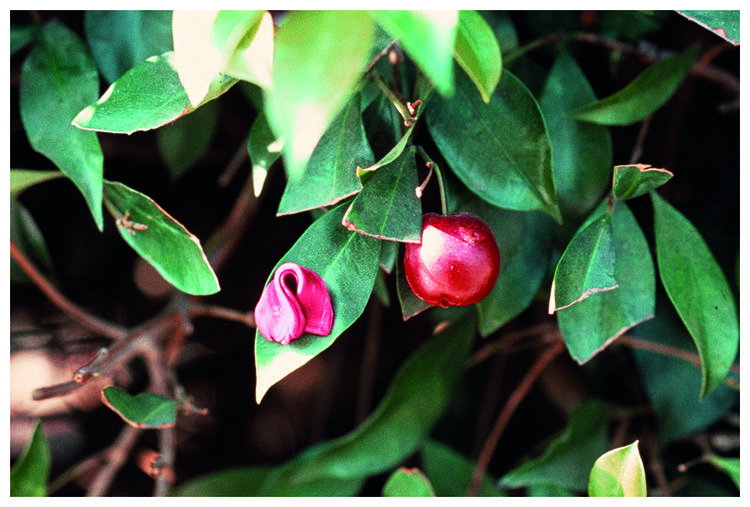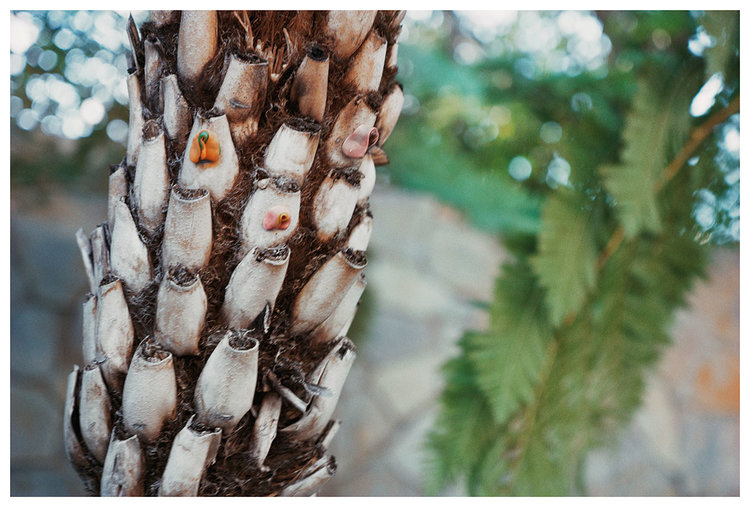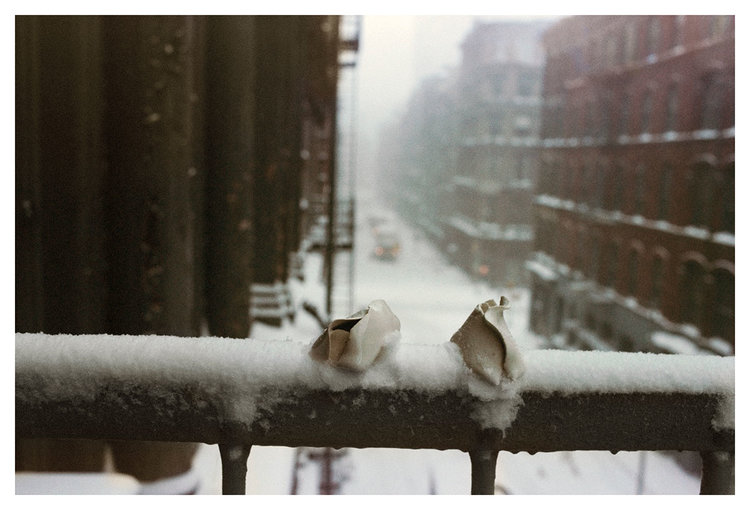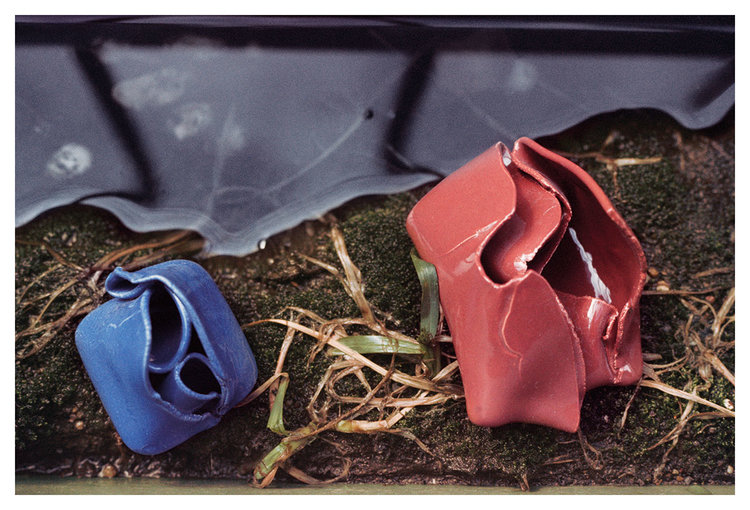Walking into
Sculptures in the Landscape at Temple Contemporary, knowing only that the late Hannah Wilke was a second wave feminist artist and that these works were positioned to explore femininity and nature, I anticipated seeing a passé, narrow representation of the female body standing in for the experience of womanhood itself. Chalk it up to my coming-of-age in the twenty-first century, but art that substitutes biological female anatomy, as opposed to other experiences shared by women, doesn’t come across as particularly brave or bold in the way it must have in the late 20th century. Despite these concerns, the exhibition is an expansive, playful, and sometimes psychedelic exercise in feminist art’s sculptural malleability, and subverted the preconceptions I had going in.
 |
| Hannah Wilke, Gum in Cherry Tree, 1976, Califonia Series, Archival Pigment Print 2019, 24x36 |
Sculpture in the Landscape does center the form of the vulva, but the materials used to recreate it– chewing gum, ceramics, metal – comment on both common women’s experiences as well as the natural surroundings where these pieces of gum are placed. Most significantly, Wilke’s photographs don’t raise the form of the vulva as something unknowably magical or mysterious, but presents them in matter-of-fact contexts to emphasize their ordinariness and naturalness.
 |
| © Hannah Wilke, Untitled, 1976, Gum on Palm Trunk, Los Angeles, 24 x 36 inches |
The first room consists of Wilke’s “Gum in Landscape” series, where the artist has molded soft pieces of gum into vulvar forms and placed them in outdoor landscape settings. These little folded, curved forms in a variety of hues peek out of hollows in tree trunks, cling to leaves, settle amidst green and yellow grasses like it’s the most natural thing in the world. But the most amusing work in this series, “Red Gum on Tree Trunk”, features the gum vulva (a phrase I’d never thought I’d be writing) stuck to a textured section of tree trunk that, incredibly, looks like an eye surrounded by long lashes. It’s an inversion of Freudian phalluses everywhere, so beloved in art history: when we enter Sculpture in the Landscape, we feel as though we’re seeing vulvas all over the place. We’ve got vulvas on the eye, and on the brain. We can’t unsee them.
The compositions are, at times, counter-intuitive in their professed appreciation of the natural world. Wilke’s gum interventions, ranging from cleverly camouflaged to cheekily visible, seem like they’re technically forms of littering, of negative human actions performed upon the earth. I think of the story they tell you when you’re a little kid: that if you swallow a stick of gum, it stays in your stomach for seven years. And even though Wilke probability cleaned up the gum after she completed her photographs, these works make you wonder how long gum on a rock, or on a plant stalk, lasts when there’s no stomach acid to wear it away.
 |
| © Hannah Wilke, Untitled, 1978, Glazed Ceramic Sculptures on Fire Escape, in Snow, with View of Street, 16 x 24 inches |
The second room in Sculpture in the Landscape features photographs of forms that play more with scale. Often created as models for larger pieces, these works in metal or ceramic or wax variously echo the gum vulvas, but in other cases more closely resemble roses or fortune cookies. In many of the images, these ceramic sculptures are placed inside flower boxes against the backdrop of the bustle of New York City. The white shape at the center of the tightly-cropped photo “Untitled (Glazed Ceramic Sculpture in Flower Box, NYC)” especially looks like a half-unfurled rose, while “Untitled (Model for Large-Scale Sculpture in the Landscape)” situates the bronze forms against patchy weeds and brown, pebbly dirt, looking perfectly in place, if not totally camouflaged.
 |
| © Hannah Wilke, Untitled, 1978, Two Glazed Ceramic Sculptures in Flower Box, 16 x 24 inches |
Returning to the first room – the gum vulva room – and studying the placement and conditions of the gum forms conjures up into another tenet of contemporary feminist thought, though one that isn’t related to nature. The classic metaphor used to shame girls from exploring their sexuality is often a stick of gum, because just as you wouldn’t want to chew a stick of gum that has been chewed up all over by any number of people, men apparently won’t want a woman who has explored her sexuality. And so the more clean-looking gum vulvas immediately contrast with the gum vulvas that look dirty and chewed-up, but Wilke pushes back against value judgements of prettily-colored versus less-appealing-looking gum vulvas. (Untitled) Gum with Staircase depicts a (likely) once-white piece of gum that has since turned beige into that pristine vulva form, also giving the lie to the misconception that engaging in sex stretches or misshapes vulvas and vaginas. The gum might have been touched and handled and even chewed, but it’s still recognizably a perfectly fine piece of gum for Wilke’s purposes; a girl’s sexuality has no bearing on her value as a human being.
 |
| © Hannah Wilke, Gum With Berries, California Series, Archival Pigment Print 2019, 24x36 in HWCALA, c Scharlatt |
In “Gum with Berries,” red-pink gum vulvas are placed along a branch of un-ripened green berries, appearing like blooming flowers, while “Gum in Cherry Tree” is downright seductive: a red gum vulva sits on a vivid green leaf beside a red cherry, causing you to hold your breath as the precarious position of the gum seems to defy the expectation that it will fall off and be dirtied by the ground. The longer you look, the more uncomfortably sensual it is, but the forms feel increasingly integrated into the compositions. This camouflage comes to a head in works like “Gum on Rock with Foam”, where the gum vulvas blend in like odd barnacles clinging to the rock at first glance, while “Gum on Rock in Water” presents the gum vulvas as stubborn little mollusks--all totally natural, presented out in the open, and nothing to be ashamed of.
Sculpture in the Landscape may seem visually overwhelmed with vulvas, but it’s more expansive – its success lies in its ability to avoid potential pitfalls of using them as a universal feminine representation. While these photographs depict shapes that reference that particular body part, they do so in a way that emphasizes both their unique and utterly banal qualities, whether lying out in a grassy field or in the middle of a crowded city.





Comments
Post a Comment